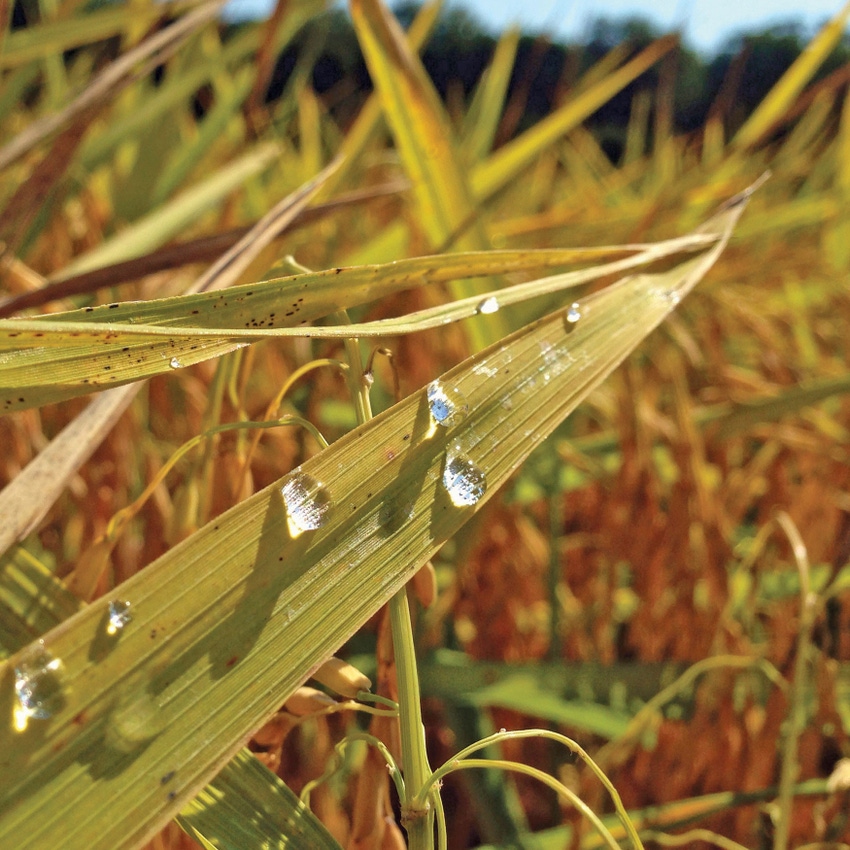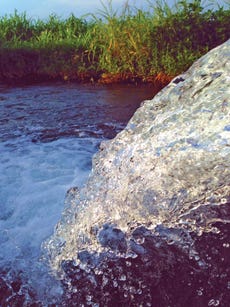October 29, 2014

EDITOR’S NOTE: Mark Isbell is a rice producer in Lonoke County, Ark.
At mid-season, there wasn’t any water on our rice field up by the highway. I am sure our neighbors wondered why. The rice wasn’t under stress or disease pressure that forced us to drain it, and we weren’t in a drought. What we were trying to do was participate in a new kind of farming — one that we can do at the same time as farming our rice, and save substantial amounts of water. We were trying to “farm” carbon.
Greenhouse gases (GHGs) are in the news a lot these days, and everyone seems to have an opinion. But whether or not you think GHGs are a problem, one fact seems clear: there is a potentially lucrative and growing market for carbon offsets, and rice farmers can possibly take part in it.
Recent research indicates that a few small tweaks in how we farm rice could significantly reduce greenhouse gas emissions while saving water and lowering input costs. It isn’t reasonable to implement these changes in all situations or on 100 percent of anyone’s production, but doing so on some of our acreage could make a big difference, and potentially be a new source of revenue. By making some voluntary changes in the short term, we can perhaps head off undesirable regulatory approaches in the future. This may be our opportunity to control the process.
Alternate wetting and drying

WATER USE on fields using AWD can be reduced up to 18 percent, which could translate to as much as $20 per acre savings.
One practice found to mitigate GHGs is alternate wetting and drying (AWD). Instead of going to permanent flood and staying there for the whole season, the goal is to flood the rice and then allow the water to evaporate and the soil to see some air before re-flooding. This is what we were doing in our field, and it is not really different than a traditional straight-head drain. “One or more of these cycles,” says Dr. Merle Anders, “can substantially reduce GHGs by temporarily changing the soil chemistry from an anaerobic to aerobic state.” In fact, recently published research by Anders and others indicates that GHG emissions can be reduced by as much as 45 to 90 percent using this practice alone.
The practice is not without risks. Over-drying could stress the plant and lead to lower yields. The goal is to find the soil moisture that allows us to grow the rice without any yield reduction while also mitigating as much greenhouse gas as possible. There are fields on our farm, due to soil type and the speed with which we are able to irrigate them, that this wouldn’t be practical. But just because you can’t do something everywhere doesn’t mean that you shouldn’t try it somewhere. It will work on a lot of our fields. And where we implement it there are potential benefits beyond the GHG offsets. Research shows that overall water use on those fields using AWD can be reduced up to 18 percent, which alone could translate to as much as $20 per acre savings.
But what about nitrogen loss? Research indicates that as long as the flood is maintained for at least 10 to 12 days after the nitrogen is applied, the N is essentially locked. In fact, says Anders, “Drying down after that can actually lead to a spike in the availability of organic N that would otherwise be unavailable to the plant.”
Another important practice in mitigating GHGs is achieving optimal N rates. Researchers seem to agree that under-fertilization is not beneficial in mitigating GHGs because yield reductions defeat the purpose. Lower yields result in more GHGs per pound of rice produced. However, over-fertilization can lead to spikes in nitrous oxide emissions, which is not a good thing if we are trying to create an offset. Optimal rates of nitrogen are the goal. The only N application that might need to be left behind is that “just-in-case because it is looking a little yellow” shot that we have all done from time to time. Right now, 135 units of N total seems to be the magic number, though that will vary with soil type and cultivar choice.
Benefits
In addition to the water and fertilizer savings , the GHG offsets created through these practices are also marketable. Many companies are voluntarily seeking to lower their carbon footprint, and to do so they are willing to buy GHG offsets from others. Add to this the recently implemented cap-and-trade market in California and you have growing demand for the offsets that we can create right here in the Mid-South.
According to Kyle Hemes with the American Carbon Registry (ACR), the pricing of carbon offsets can vary widely, but there is evidence that offsets created from agricultural activities might trade at a premium. In other words, not only might offset demand be increasing, but offsets created through agricultural activities, says Hemes, may be in more demand than those from other activities.
Though the amount of GHGs mitigated in any given field will vary, some put the potential per-acre revenue over $10 per acre with the potential for more as the market continues to develop.
How it works
To make this work, not only is it necessary to have farmers willing to implement this research, but you also have to line up potential buyers of the offsets and have a third-party who can verify that legitimate offsets have been created. This is already taking place. Entergy Corporation has stepped forward with critical financial assistance in the form of substantial matching grants to help get this process started, and Dennis Carman of the White River Irrigation District has played an important role in bringing all the parties together to make this possible.
A protocol incorporating practices like intermittent flood and using optimal N rates has been developed by Terra Global Capital in cooperation with The American Carbon Registry, a non-profit enterprise of Winrock International. Based upon which of the practices a farmer is willing to adopt, a series of calculations will determine the amount of marketable offsets that have been created, which are then verified and sold.
Carbon credit payments, at least at current levels, will likely not be large enough to directly influence growers to change practices. However, when looking at the total package, the benefits are hard to ignore.
Carman says, “I believe we can reduce water use by 6 inches per year on a normal year, reduce nitrogen use by 50 pounds per acre, maintain yields, and trade the carbon credits for additional revenue. That should be attractive for many growers.”
While Carman’s take may seem overly optimistic, the potential here is worth exploring, which is exactly what we have decided to do on one field on our farm this year.
“Our goal,” says Carman, “is to demonstrate that agriculture can implement carbon reduction techniques in rice production voluntarily. Regulations are not only unnecessary, but they would be the most inefficient route to take. We believe the farmer-driven practices being advocated will reduce pumping costs and fertilizer cost, and maintain yields. If we save water, save fertilizer, maintain yields, and generate additional income from the carbon trading, it’s hard to see a negative.”
Jim Whitaker, of Dermott, Ark., is one farmer participating this season. “Our farm has always tried to be proactive in finding ways to save water,” he says. This first led us to zero grade as the ultimate water conservation practice in rice production. A couple of years ago we started exploring the possibility of intermittent flood as a way to increase these savings further, and we have noticed significant water savings.”
Whitaker is hopeful that this will also lead to revenue from GHG offsets while encouraging sustainable practices: “When I heard about the GHG work being done and the possibility of it having a positive effect on continuous rice yields, I was sold. With all the talk in our industry about sustainability, this could have a huge positive influence on the environment and hopefully offer farmers payments for implementing these practices. This is an opportunity to create a farmer-led, voluntary program.”
The program is now looking to expand. Carman says there were about 500 acres in the program last year and there are 15 farmers with 2,700 acres in Arkansas and Mississippi participating this season. “What we need now is a larger group of farmers over a wider area who are willing to give this a try. Next year, I would like to see 50 growers and 10,000 acres or more. I would also like to expand into Missouri and Louisiana.”
Meanwhile, our 70-acre field up on the highway is dry again, but this time because it has been drained for harvest. I won’t know the yield for a few weeks yet when the combine rolls in, but the field looks good. I don’t know how the carbon crop turned out yet either, but I am hopeful. We are learning something new and, I believe, working toward the future. I’ll let you know how it turns out.
Mark Isbell can be reached at [email protected], or on twitter @mjisbell.
If you are interested in learning more about this program, contact Dennis Carman at: [email protected].
You May Also Like




